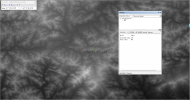Kang Huang
New member
Hi,
I have now made a three-layer nested domains simulation with a ratio of 1:3:3, the grid accuracy of the finest nested area is 1km, and then the longitude and latitude of my target site is very close to one of the grid points in the 3rd nested domain. The distance is only about ten meters. But the output altitude (HGT) of this grid point in the output file after geogrid.exe is more than 100 meters different from the actual one (actual about 900m, simulated about 760m).
Regardless of whether I use the default 30s terrain data that comes with WRF, or the high-resolution terrain data of SRTM 3s and SRTM 1s, or change the interp_option option in GEOGRID.TBL.ARW (set it four_pt or nearest), this problem will still occur.
I want to know what causes this and is there any solution? Because altitude is also a vital parameter when performing WRF simulations.
Ps:
Best regards!
I have now made a three-layer nested domains simulation with a ratio of 1:3:3, the grid accuracy of the finest nested area is 1km, and then the longitude and latitude of my target site is very close to one of the grid points in the 3rd nested domain. The distance is only about ten meters. But the output altitude (HGT) of this grid point in the output file after geogrid.exe is more than 100 meters different from the actual one (actual about 900m, simulated about 760m).
Regardless of whether I use the default 30s terrain data that comes with WRF, or the high-resolution terrain data of SRTM 3s and SRTM 1s, or change the interp_option option in GEOGRID.TBL.ARW (set it four_pt or nearest), this problem will still occur.
I want to know what causes this and is there any solution? Because altitude is also a vital parameter when performing WRF simulations.
Ps:
- I used gdal & convert_geotiff to implement merge and binary conversion of srtm.tif files.
Code:
gdal_merge.py -o MyTarget.tif -a_nodata -32768 --optfile tif_list.txtBecause the ocean part is not included, no additional processing is done. At the same time, the coordinates, resolution and other information of the index file are also set according to .hdr&.tfw. You can see it in the attachment.Code:convert_geotiff -w 4 -t 1500 -u "meters MSL" -d "3s topography" -b 0 -m -32768 MyTarget.tif - I check the origin srtm.tif file using arcGIS, by positioning the accurate longitude and latitude coordinates, we can see that the altitude is still close to the actual value. After domain nesting setting in namelist.wps and geogrid.exe, we got a grid point in D03, located in (40°23′45.38″N,117°34′28.28″E)。
- I read the Chapter 3 in WRF User Guide: Ideally, the map projection and its accompanying parameters should be chosen to minimize the maximum distortion within the area covered by the model grids, since a high amount of distortion, evidenced by map scale factors significantly different from unity, can restrict the model time step more than necessary. Does this mean that because of the limitations of projection, I cannot locate a certain point on the static terrain very accurately?
Best regards!

